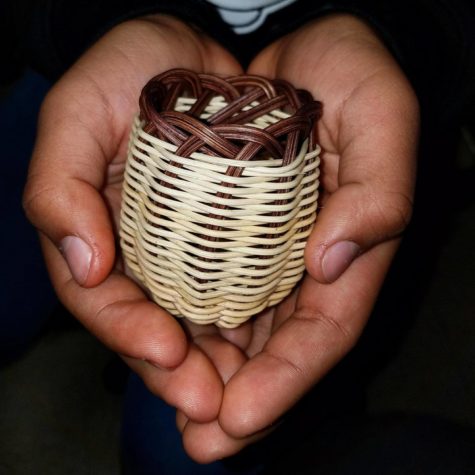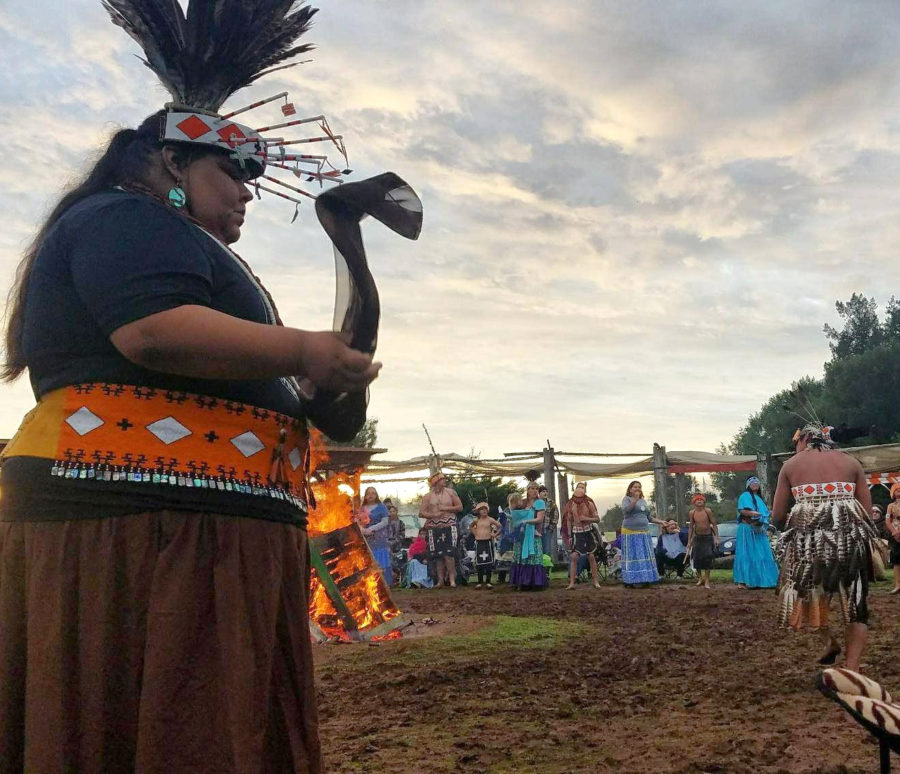Angelica root. Sweet grass. Pepperwood leaves. White mountain sage.
Thanksgiving morning smells different for Rose Hammock, 21, a SRJC student studying early childhood education and behavioral sciences.
At 4:30 a.m. Hammock lights each plant and drops it into a clay pot, emitting smoke. She takes a turkey feather fan and waves the smoke over her regalia, her dresses and headpieces for special occasions. She carries her regalia down the hall, says a prayer, wafts the smoke over her hair and chest, and leaves with her family for the outskirts of Forestville, California.
Hammock is a member of the Pomo and Wailacki Tribes in the Round Valley Indian Reservation. Her community celebrates Thanksgiving with the Sunrise Ceremony.
When her family arrives at 5:30 a.m., people are already gathering at the dance arbor, called Ya-ka-ama in the coastal Pomo language. The crowd socializes until one or two singers speak out and thank everyone for being there that morning. Hammock and the other dancers change into their regalia.
The dancers line up. The singers begin to sing. The dancers begin to dance.
“When we dance, that’s prayers,” Hammock said.
About halfway through the dancing, the sun starts to rise.
“My belief is that it’s like our church. People will come just to be there during our ceremony. They come just to watch us and take in our prayers while we dance,” Hammock said.
Joe Salinas, Sonoma County Pomo Dance Group Leader, said they give thanks every day, not just on Thanksgiving. Waking up early and wearing only the regalia on the cold morning of the Sunrise Ceremony is a way to give sacrifice for what you have.
“My grandmother is full-blooded Pomo and she raised me to dance. In honor of her, not only do I dance but I became a dance group leader to teach our community about our culture,” Salinas said.
Salinas is a staff member in the Healthy Traditions Department of Sonoma County Indian Health Project, SCIHP, in Santa Rosa. He began the Native Youth Pomo Dance group that Hammock is a part of.
Hammock first started dancing when she was in middle school. She wasn’t hanging out with the right people, as she describes it, and her aunt encouraged her to join the SCIHP dance group, which meets once a week.
The classes begin with students learning to make their own regalia.
After making their clothing, the girls learn the movements from the elderly women while singers sing the songs. In a separate class, boys learn their own dances.
After four or five years of dancing, Hammock was asked to be the lead female dance teacher. She now teaches the girls and helps them wear and respect their regalia.
“It makes you feel good, that we are keeping the culture strong,” said Evelyn Ferrel, an SCIHP singer.
Ferrel has been a singer since 1995 and has watched Hammock grow up.
“Rose is a great teacher,” Ferrel said, “She is highly respected by all ages in the community. I learn so much from Rose.”
Since expanding her role in the dance community, Hammock has brought her culture to the local schools.
“I’ve had a lot of opportunities outside of the dance group to be a teacher in the community. I do cultural presentations at elementary schools to bring awareness to non-Native kids in our community,” Hammock said.
She visits preschools in Roseland, bringing her regalia and small baskets for the children to see up close.
“I teach that you can be proud of yourself,” she said.
Hammock knows how impactful it can be to share her culture with students at a young age.
“Us indigenous people are resilient and we’re blessed. It turns the gears in their head to think, oh this person can get involved in their culture, so that means that I can get involved in my culture,” Hammock said.

In the next year Hammock plans to graduate from SRJC. In the next 5 to 7 years she hopes to work with different Native organizations in California and Washington to create a blueprint for developing her own community building in Sonoma County.
The community building would be a place to hold classes, potlucks and cultural and educational presentations.
“I live in Roseland and I see kids walking the streets at night. I feel like with this community building, I could give a safe place to these young people,” Hammock said.
The Sunrise Ceremony usually ends by 8 a.m. This year was muddy, so Hammock went straight home after to clean up. The rest of the day she spent with family, much like many Americans do on Thanksgiving.
“I get a lot of questions around stereotypes. When I explain my lineage, people think that’s exactly where I live. People think all Indian people live on reservations or that all Indian people get money. It’s not like that,” Hammock said.
Outsiders often do not have an accurate idea of what her community has endured.
“A lot of our tribes have lost our traditional languages and our traditional foods,” Hammock said.
Being involved in the dance community and educating children is one of the most effective ways for Hammock to ensure the continuation of her tribe’s traditions.
“We need to give more of our time and our energy back to our culture in more traditional ways,” Hammock said. “Us as young people, unless we carry it on, it’s going to continue to get lost.”


